Growing tomatoes indoors is not only a fun and fulfilling hobby, but it also allows you to enjoy the delicious taste of homegrown tomatoes year-round. Did you know that indoor tomato gardening has been gaining popularity, with a 350% increase in searches over the past five years? It’s no wonder that more and more people are discovering the joy of growing their own tomatoes indoors.
Key Takeaways:
- Indoor tomato gardening is a trending practice with a significant increase in popularity over the years.
- Growing tomatoes indoors allows you to have fresh, homegrown tomatoes all year round.
- Indoor tomato gardening requires specific tips and tricks to ensure successful growth and abundant harvests.
- Choosing the right tomato varieties, providing adequate light, controlling temperature and environmental conditions, proper watering and fertilizing, pollination techniques, pruning and training, choosing suitable containers, and harvesting and storing techniques are essential for indoor tomato gardening success.
- By following these tips and tricks, you can create an optimal environment for your indoor tomato plants and enjoy a continuous supply of delicious tomatoes.
Choosing the Right Tomato Varieties for Indoor Growing
When it comes to indoor tomato gardening, selecting the right tomato varieties is key to a successful harvest. Tomato varieties for indoor growing should be well-suited to the indoor environment, compact, and bushy. These characteristics ensure that tomato plants thrive in confined spaces and can be easily managed indoors.
Some of the best tomatoes to grow indoors are compact and bushy varieties, such as “patio” or “bush” tomatoes. These types of tomatoes don’t require as much space to grow, making them ideal for indoor gardening. Additionally, look for tomato varieties that produce small fruits like cherry, grape, Roma, and small slicer types. These varieties tend to perform well indoors and provide a plentiful yield.
| Recommended Tomato Varieties for Indoor Growing |
|---|
| ‘Patio Choice Yellow’ |
| ‘Tumbler’ |
| ‘Bush Early Girl’ |
| ‘Atlas’ |
These recommended varieties are known for their adaptability to indoor environments and their ability to produce high-quality tomatoes. Whether you prefer a sweeter taste, a bold flavor, or a combination of both, there’s a tomato variety to suit your preferences and growing conditions.
Experiment with different tomato varieties to discover which ones thrive in your indoor garden. Each variety may have unique growth habits, flavors, and fruit sizes, allowing you to explore and enjoy a diverse range of homegrown tomatoes throughout the year.
Providing Adequate Light for Indoor Tomato Plants
Tomato plants require sufficient light to grow and produce fruit. While natural sunlight is best, it may not be enough, especially during the winter months. To ensure your indoor tomato plants receive the right amount of light, consider using grow lights or shop lights as a supplemental light source.
Position the lights a few inches above the plants to simulate the intensity and proximity of natural sunlight. Ideally, you should keep the grow lights on for 18 to 22 hours per day to mimic the long daylight hours tomatoes typically receive outdoors.
Adequate light is crucial for the growth and development of indoor tomato plants. It promotes photosynthesis, which is essential for energy production and healthy plant growth. Without sufficient light, your plants may become weak and leggy, and fruit production may be limited.
Choosing the Right Grow Lights
When selecting grow lights for your indoor tomato plants, there are a few options to consider:
- Fluorescent lights: T5 fluorescent lights are a popular choice for indoor gardening. They are energy-efficient, emit a balanced spectrum of light, and produce less heat compared to other types of grow lights.
- LED lights: LED (Light Emitting Diode) lights are highly efficient and can be tailored to provide specific light wavelengths that promote plant growth. They have a longer lifespan and produce less heat than other types of grow lights.
- HID lights: High-Intensity Discharge (HID) lights, such as Metal Halide (MH) and High-Pressure Sodium (HPS) lights, are powerful and commonly used for commercial indoor growing. They emit strong light intensity but generate more heat and require proper ventilation.
The specific type of grow light you choose will depend on your budget, space, and the number of tomato plants you are growing indoors. It’s important to note that different stages of tomato growth require varying light intensities. Consult the manufacturer’s guidelines or a gardening expert to determine the appropriate distance and duration for your grow lights.
Temperature and Environmental Considerations for Indoor Tomato Gardening
When it comes to indoor tomato gardening, temperature is a key factor that can greatly influence the success of your plants. Tomatoes thrive in temperatures between 70 and 80°F, creating the ideal environment for healthy growth and bountiful harvests.
One of the most important things to remember is to avoid exposing your tomato plants to cold drafts or blasts of hot air from vents. These sudden temperature changes can stress the plants and hinder their development. Shielding your plants from temperature fluctuations is crucial for their overall health and productivity.
“Maintaining a warm and stable growing environment is essential for the success of your indoor tomato garden.”
Proper air circulation is another aspect to consider. While it’s important to protect your plants from strong drafts indoors, ensuring adequate air movement is necessary to prevent fungal problems. An oscillating fan can be a great solution to mimic gentle breeze and promote healthy air circulation around your tomato plants.
By creating a warm and stable environment while maintaining proper air circulation, you can provide the optimal temperature and environmental conditions for your indoor tomato plants to thrive.
Recommended Temperature and Environmental Conditions for Indoor Tomato Gardening
| Temperature | Environmental Conditions |
|---|---|
| 70-80°F | Avoid exposing plants to cold drafts or hot air blasts |
| Shield plants from temperature fluctuations | |
| Ensure proper air circulation |
Watering and Fertilizing Indoor Tomato Plants
Indoor tomato plants require specific care when it comes to watering and fertilizing. To ensure healthy growth and a fruitful harvest, it’s important to meet their unique needs.
- Watering: Check the soil daily by inserting your finger about an inch down. If it feels dry at this depth, it’s time to water. Be careful not to overwater, as this can lead to root rot. To avoid waterlogging, place a saucer or tray underneath the pot to catch any excess water and allow for proper drainage.
- Fertilizing: Indoor tomato plants need regular fertilization to replenish the nutrients that are lost through frequent watering. Consider using a slow-release pelleted plant food or a water-soluble fertilizer suitable for edible plants. Follow the package instructions for dosage and frequency, taking care not to over-fertilize, as this can harm the plants.
By maintaining a careful balance of watering and fertilizing, you can provide your indoor tomato plants with the nutrients they need to thrive and produce a bountiful crop of delicious tomatoes.
Remember, each tomato variety may have slightly different requirements, so it’s always a good idea to refer to specific care instructions for the variety you are growing.
“Proper watering and fertilizing are key factors in the success of indoor tomato gardening. By providing adequate moisture and essential nutrients, you can help your plants grow strong and healthy, resulting in a plentiful harvest.” – Me
Pollination Techniques for Indoor Tomato Plants
Indoor tomato plants require assistance with pollination as there are no outdoor pollinators like bees or wind. To ensure a successful fruit set, it’s essential to promote pollination in your indoor tomato garden. Here are a few techniques you can use:
Gentle Shaking or Fan Movement
One simple way to encourage pollination is by gently shaking the tomato plants daily. This mimics the movement of wind and helps transfer pollen between the flowers. Alternatively, you can use an oscillating fan set to a low speed to provide a gentle breeze in your indoor garden. This movement will assist in pollen transfer and increase the chances of successful pollination.
Hand Pollination
If you want to take a more hands-on approach, you can opt for hand pollination. This involves manually transferring pollen from one flower to another. To hand pollinate tomato plants, lightly touch each blossom with a cotton swab. Gently brush the swab against the stamen, where the pollen is produced, and then transfer it to the pistil, the female part of the flower. This ensures efficient pollen transfer and enhances the chances of fruit formation.
By employing these pollination techniques, you can overcome the absence of natural pollinators in your indoor tomato garden and help ensure a successful harvest.
Pruning and Training Indoor Tomato Plants
Pruning and training are essential techniques for the successful growth of indoor tomato plants. By implementing these practices, you can optimize plant growth, improve fruit quality, and maximize your harvest. Here are some expert tips for pruning and training your indoor tomato plants:
Pruning:
To redirect energy towards fruit production, it is crucial to remove small stems called suckers that grow from the main stem of your tomato plant. Suckers are the small, leafy shoots that emerge between the main stem and the branches. By removing these suckers, you can ensure that the plant’s energy is focused on developing larger, healthier fruits.
When pruning, use a sharp, sterilized pair of pruning shears or scissors to make clean cuts. Remove suckers when they are small and easy to snap off, usually around ⅛ to ¼ inch in diameter. Avoid removing too many leaves, as they play a vital role in photosynthesis and energy production for the plant.
Training:
Training your tomato plants involves providing support and structure to guide their growth. This helps prevent sprawling and allows for better airflow and light penetration, ultimately leading to healthier plants and increased yields.
There are several methods for training tomato plants, including stakes, trellises, cages, or a combination of these. Choose a method that suits your space and preference. Here are a few popular options:
- Stakes: Insert sturdy stakes into the soil, placing them near the main stem of the plant. Gently tie the main stem to the stake using soft plant ties or twine. As the plant grows, continue to secure the stem to the stake to provide stability and support.
- Trellises: Install trellises behind your tomato plants. As the plants grow, carefully weave the main stems through the trellis, encouraging them to grow vertically. This method helps save space and prevents the plants from sprawling.
Remember to regularly rotate your pots to ensure equal exposure to light and prevent your plants from bending towards the light source. This will help promote balanced growth and prevent the development of weak stems.
Additionally, proper pruning and training, along with adequate light, watering, and fertilizing, will create a healthy environment for your indoor tomato plants, leading to a successful and fruitful harvest.
| Benefits of Pruning and Training Indoor Tomato Plants | How to Prune and Train Tomato Plants |
|---|---|
| 1. Redirects energy towards fruit production | 1. Identify and remove suckers |
| 2. Improves airflow and prevents disease | 2. Use sharp, sterilized tools to make clean cuts |
| 3. Increases light penetration to lower foliage | 3. Avoid removing excessive leaves |
| 4. Prevents sprawling and saves space | 4. Choose appropriate support methods (stakes, trellises, cages) |
| 5. Promotes balanced growth and even exposure to light | 5. Rotate pots regularly |
Choosing the Right Containers for Indoor Tomato Gardening
Selecting the right containers is essential for successful indoor tomato gardening. The size and material of the containers play a vital role in the overall health and growth of your indoor tomatoes. Here are some tips to help you choose the perfect pots for your indoor tomatoes:
- Size matters: Opt for pots that are at least 14 inches wide and 20 inches deep. This will provide enough space for the extensive root system of tomato plants.
- Drainage is key: Ensure that the containers have proper drainage holes to prevent waterlogging. Good drainage is crucial for the health of your tomato plants.
- Consider self-watering containers: To maintain optimal moisture levels, you can consider using self-watering containers. These containers have built-in reservoirs that provide water to the plants as needed.
- Try fabric grow bags: Fabric grow bags are another excellent option for indoor tomato gardening. They offer good drainage while allowing air to reach the roots, promoting healthy growth.
Choosing the right containers will create a favorable environment for your indoor tomatoes to thrive. Now let’s take a look at a comparison of different container options:
| Container Type | Pros | Cons |
|---|---|---|
| Traditional Pots | – Availability in various sizes and materials – Easily accessible |
– May require more frequent watering – Can be more prone to waterlogging if drainage is inadequate |
| Self-Watering Containers | – Reduce the need for frequent watering – Provide consistent moisture levels |
– Costlier than traditional pots – Limited variety of sizes and materials |
| Fabric Grow Bags | – Good drainage and aeration – Lightweight and portable |
– Can dry out quickly, requiring more frequent watering – Limited durability compared to other container types |
By considering these options and choosing the right containers for your indoor tomato gardening, you will set your plants up for success.
Harvesting and Storing Indoor Tomatoes
Harvesting indoor tomatoes is an exciting and rewarding milestone in your indoor gardening journey. To ensure the best flavor and texture, it’s important to pick the fruits at the right time and store them properly. Here are some tips for harvesting and storing your indoor tomatoes:
- Pick tomatoes when they have developed their color and are still firm. This is the optimal stage for harvesting as the fruits will continue to ripen off the vine.
- Twist and snap the tomatoes near the stem to harvest them. Be gentle to avoid damaging the plant or the fruit.
- After harvesting, it’s important to store the tomatoes in the right conditions to preserve their flavor and quality.
- Avoid refrigerating tomatoes as the cold temperatures can affect their taste and texture. Instead, store them at room temperature.
- Place the tomatoes in a single layer in a cool, well-ventilated area. Avoid stacking them on top of each other, as this can cause bruising and spoilage.
- Check the tomatoes regularly and remove any that show signs of spoilage or rot. This will help prevent the spread of decay.
By following these tips, you can enjoy the delicious taste of homegrown tomatoes all year round. Whether you use them in salads, sauces, or sandwiches, your indoor tomatoes will add a burst of freshness to your meals.
Conclusion
Indoor tomato gardening offers a wonderful way to enjoy the taste of fresh, homegrown tomatoes throughout the year. With the right techniques and attention to detail, you can create an optimal growing environment for your indoor tomato plants and achieve a successful harvest. Remember to experiment with different tomato varieties, lighting setups, and pruning techniques to find what works best for you.
By following the tips and tricks shared in this article, you can embark on a rewarding indoor tomato gardening journey. Provide your plants with adequate light, maintain the right temperature and environmental conditions, and ensure proper watering and fertilization. Don’t forget about the important aspect of pollination, whether through gentle shaking or hand pollination. Additionally, pruning and training your plants will help promote better growth and higher yields.
When it comes to choosing the right containers, opt for pots that are spacious enough to accommodate the root system of your tomato plants, while also having proper drainage. Finally, harvest your tomatoes when they are firm and have developed their color, and store them at room temperature for the best flavor and texture.
With dedication and practice, you’ll soon be enjoying the satisfaction of growing your own juicy, vine-ripened tomatoes indoors. So, why wait? Start your indoor tomato gardening adventure today and savor the delicious taste of homegrown tomatoes at any time of the year!

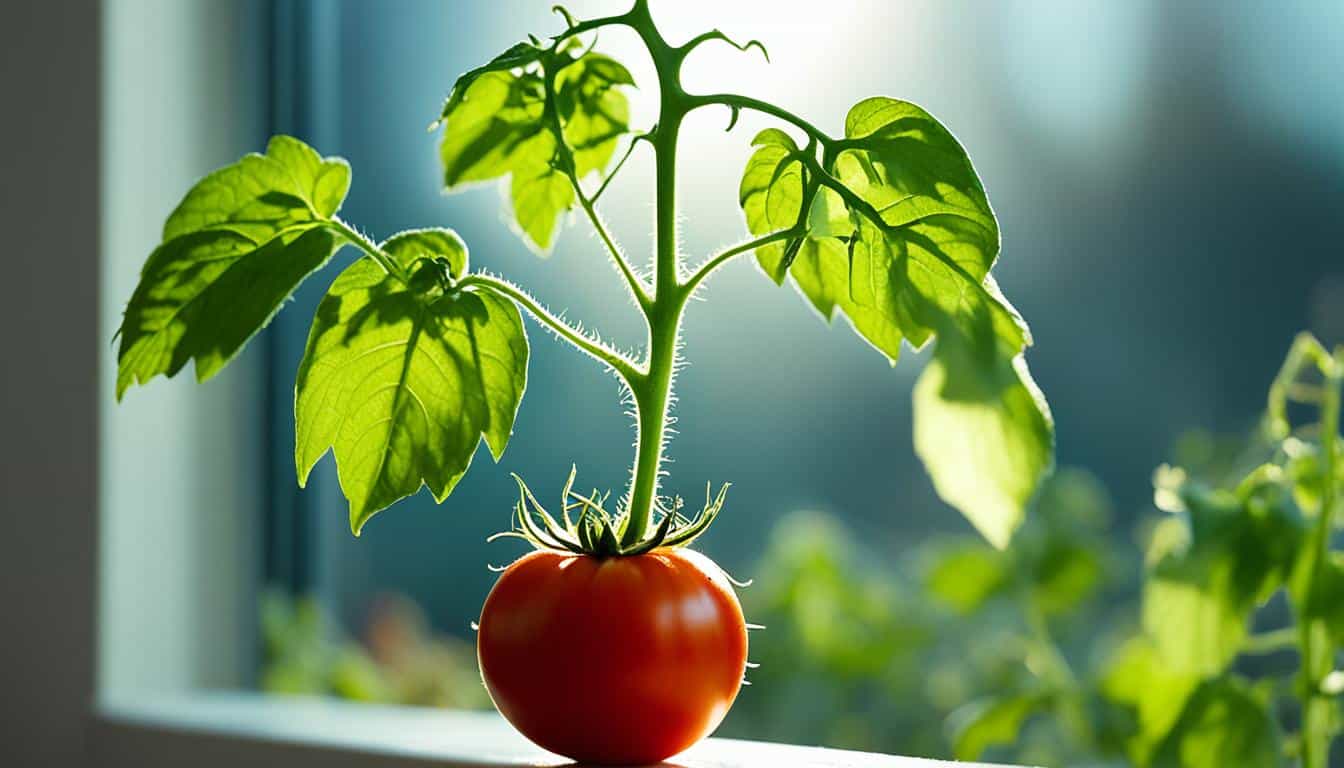
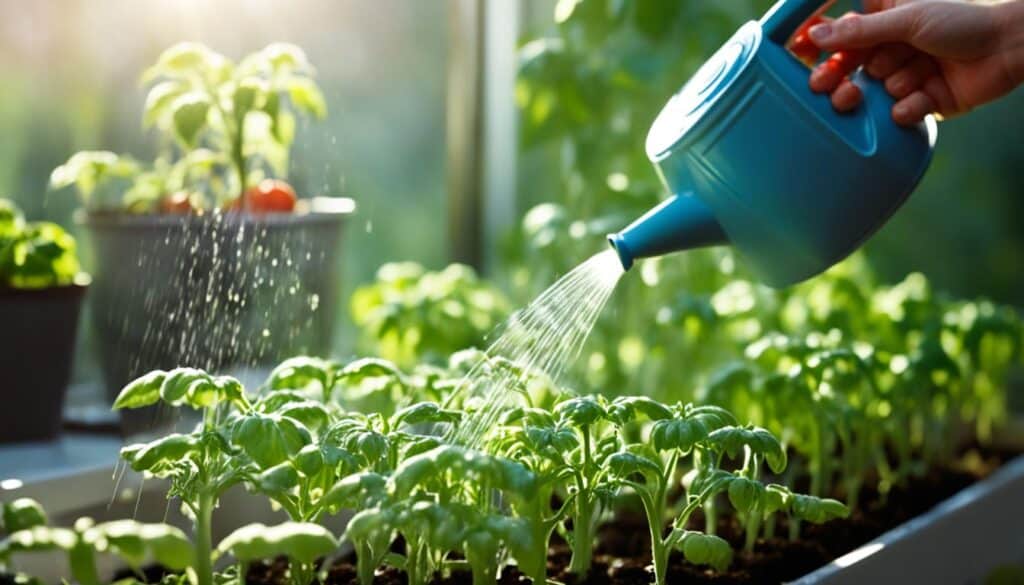
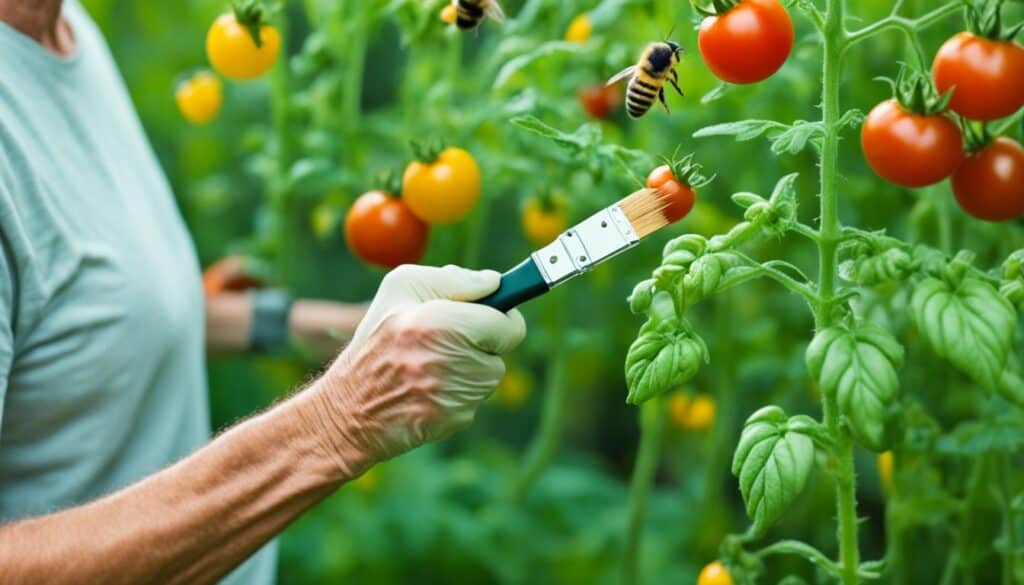

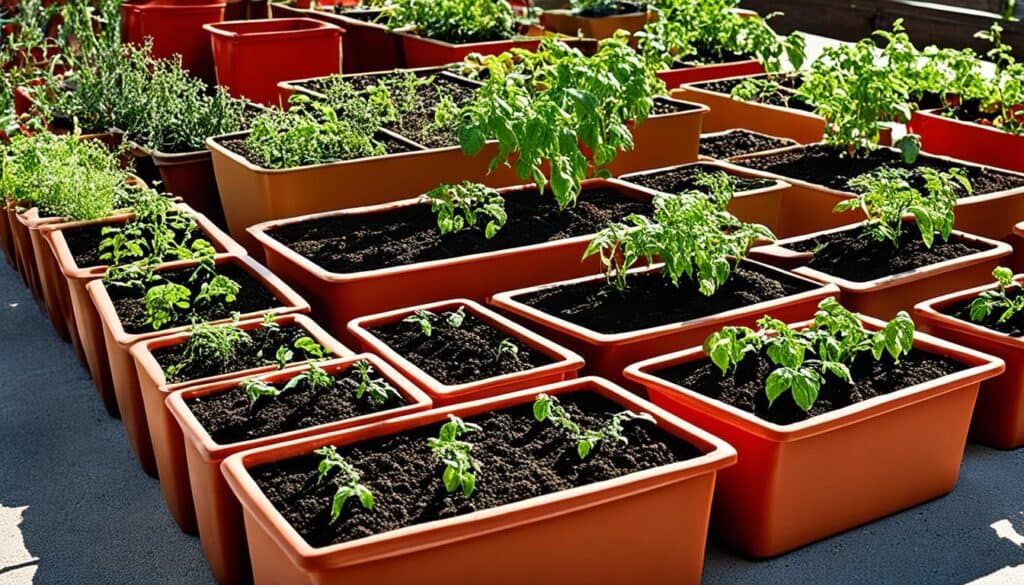
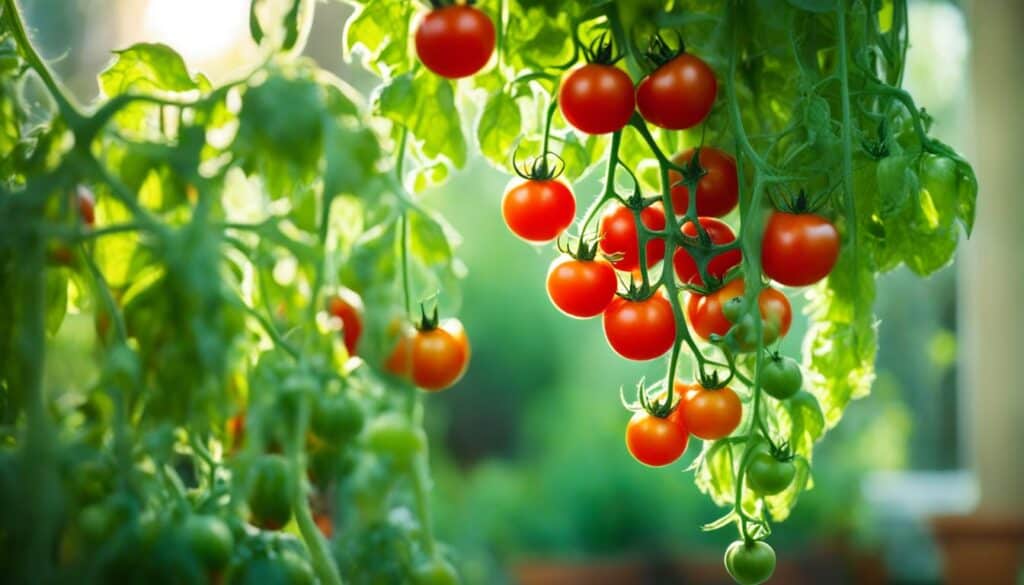



Leave a Reply